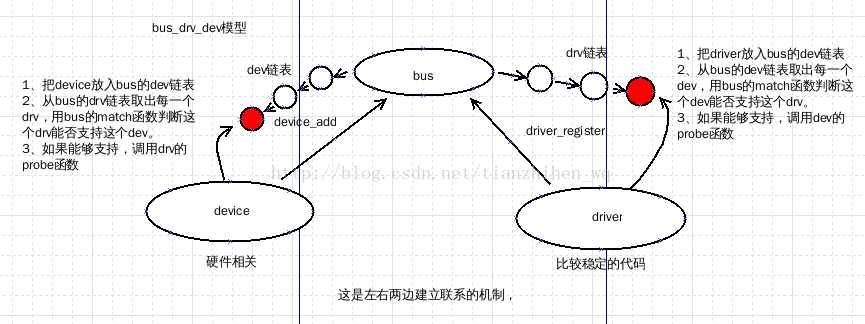linux驱动的分离分层概念
Posted
tags:
篇首语:本文由小常识网(cha138.com)小编为大家整理,主要介绍了linux驱动的分离分层概念相关的知识,希望对你有一定的参考价值。
bus_drv_dev模型:功能改写只需改dev硬件代码即可,drv不需改写。

LED例子
下面用一个点亮LED的例子来说明这个分离的的例子:
led_dev.c 定义这个平台设备的资源:
static struct resource led_resource[] = {
[0] = {
.start = 0x56000010, //GPFCON的物理地址
.end = 0x56000010 + 8 - 1,
.flags = IORESOURCE_MEM,
},
[1] = {
.start = 6,// F6引脚
.end = 6,
.flags = IORESOURCE_IRQ,
},
};
定义一个平台设备:
struct platform_device device_led = {
.name = "myled",
.id = -1,
.num_resources = ARRAY_SIZE(led_resource),
.resource = led_resource,
.dev={
.release = led_release,
},
};
在入口函数中 注册 这个 “平台设备”
static int led_dev_init(void)
{
platform_device_register(&device_led);
return 0;
}
出口函数是卸载这个平台设备
static void led_dev_exit(void)
{
platform_device_unregister(&device_led);
}
led_drv.c 定义一个平台driver
static struct platform_driver led_drv = {
.probe = led_probe,
.remove = led_remove,
.driver = {
.name = "myled",
}
};
这里需要注意的是这个平台的name和dev的平台设备的名字要一致。如果平台设备和平台driver匹配的上,就会调用这个led_driver这个函数。
/* 分配/设置/注册一个platform_driver */
#include <linux/module.h>
#include <linux/version.h>
#include <linux/init.h>
#include <linux/fs.h>
#include <linux/interrupt.h>
#include <linux/irq.h>
#include <linux/sched.h>
#include <linux/pm.h>
#include <linux/sysctl.h>
#include <linux/proc_fs.h>
#include <linux/delay.h>
#include <linux/platform_device.h>
#include <linux/input.h>
#include <linux/irq.h>
#include <asm/uaccess.h>
#include <asm/io.h>
static int major;
static struct class *cls;
static volatile unsigned long *gpio_con;
static volatile unsigned long *gpio_dat;
static int pin;
static int led_open(struct inode *inode, struct file *file)
{
//printk("first_drv_open\\n");
/* 配置为输出 */
*gpio_con &= ~(0x3<<(pin*2));
*gpio_con |= (0x1<<(pin*2));
return 0;
}
static ssize_t led_write(struct file *file, const char __user *buf, size_t count, loff_t * ppos)
{
int val;
copy_from_user(&val, buf, count); // copy_to_user();
if (val == 1)
{
// 点灯
*gpio_dat &= ~(1<<pin);
}
else
{
// 灭灯
*gpio_dat |= (1<<pin);
}
return 0;
}
static struct file_operations led_fops = {
.owner = THIS_MODULE, /* 这是一个宏,推向编译模块时自动创建的__this_module变量 */
.open = led_open,
.write = led_write,
};
static int led_probe(struct platform_device *pdev)
{
struct resource *res;
/* 根据platform_device的资源进行ioremap */
res = platform_get_resource(pdev, IORESOURCE_MEM, 0);
gpio_con = ioremap(res->start, res->end - res->start + 1);
gpio_dat = gpio_con + 1;
res = platform_get_resource(pdev, IORESOURCE_IRQ, 0);
pin = res->start;
/* 注册字符设备驱动程序 */
printk("led_probe, found led\\n");
major = register_chrdev(0, "myled", &led_fops);
cls = class_create(THIS_MODULE, "myled");
class_device_create(cls, NULL, MKDEV(major, 0), NULL, "led"); /* /dev/led */
return 0;
}
static int led_remove(struct platform_device *pdev)
{
/* 卸载字符设备驱动程序 */
/* iounmap */
printk("led_remove, remove led\\n");
class_device_destroy(cls, MKDEV(major, 0));
class_destroy(cls);
unregister_chrdev(major, "myled");
iounmap(gpio_con);
return 0;
}
struct platform_driver led_drv = {
.probe = led_probe,
.remove = led_remove,
.driver = {
.name = "myled",
}
};
static int led_drv_init(void)
{
platform_driver_register(&led_drv);
return 0;
}
static void led_drv_exit(void)
{
platform_driver_unregister(&led_drv);
}
module_init(led_drv_init);
module_exit(led_drv_exit);
MODULE_LICENSE("GPL");
这个驱动程序分为左右两边,即dev与drv,在led_dev.中分配,设置,注册一个platform_device,在led_drv中分配,设置,注册一个platform_driver。
以上是关于linux驱动的分离分层概念的主要内容,如果未能解决你的问题,请参考以下文章
14.linux-platform机制实现驱动层分离(详解)